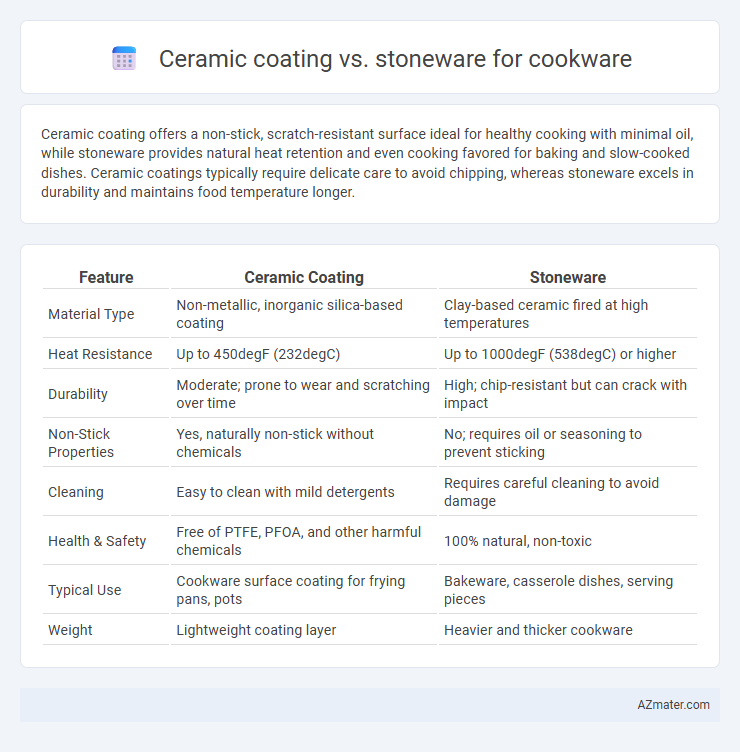Ceramic coating offers a non-stick, scratch-resistant surface ideal for healthy cooking with minimal oil, while stoneware provides natural heat retention and even cooking favored for baking and slow-cooked dishes. Ceramic coatings typically require delicate care to avoid chipping, whereas stoneware excels in durability and maintains food temperature longer.
Table of Comparison
| Feature | Ceramic Coating | Stoneware |
|---|---|---|
| Material Type | Non-metallic, inorganic silica-based coating | Clay-based ceramic fired at high temperatures |
| Heat Resistance | Up to 450degF (232degC) | Up to 1000degF (538degC) or higher |
| Durability | Moderate; prone to wear and scratching over time | High; chip-resistant but can crack with impact |
| Non-Stick Properties | Yes, naturally non-stick without chemicals | No; requires oil or seasoning to prevent sticking |
| Cleaning | Easy to clean with mild detergents | Requires careful cleaning to avoid damage |
| Health & Safety | Free of PTFE, PFOA, and other harmful chemicals | 100% natural, non-toxic |
| Typical Use | Cookware surface coating for frying pans, pots | Bakeware, casserole dishes, serving pieces |
| Weight | Lightweight coating layer | Heavier and thicker cookware |
Introduction to Ceramic Coating and Stoneware Cookware
Ceramic coating cookware features a non-stick surface made from inorganic minerals, offering excellent heat distribution and easy cleaning without the health risks associated with traditional non-stick chemicals. Stoneware cookware is crafted from natural clay baked at high temperatures, providing durability, heat retention, and an attractive, rustic finish ideal for slow cooking and baking. Both materials enhance cooking performance, but ceramic coating excels in versatility and ease of maintenance, while stoneware is prized for its heat retention and oven-safe properties.
Material Composition: Ceramic Coating vs Stoneware
Ceramic coating consists of a silica-based non-stick layer applied to metal cookware, providing a smooth, heat-resistant surface that enhances food release and ease of cleaning. Stoneware is a dense, naturally fired clay material with a porous structure, renowned for its ability to retain heat evenly and withstand high temperatures without chemical coatings. The key difference lies in ceramic coating being a thin protective layer on metal, whereas stoneware is a solid clay-based cookware formed by firing natural minerals.
Heat Distribution and Retention
Ceramic cookware offers excellent heat distribution due to its even surface, ensuring consistent cooking temperatures and preventing hotspots. Stoneware excels in heat retention, maintaining warmth longer and allowing food to stay hot after removal from the heat source. Both materials provide distinct advantages: ceramic for uniform cooking efficiency and stoneware for prolonged heat preservation.
Durability and Longevity Comparison
Ceramic coatings offer a smooth, non-stick surface that resists scratches and high heat but may wear down over time with heavy use. Stoneware cookware is known for its robust, chip-resistant build and excellent heat retention, often lasting decades when properly cared for. Durability tends to favor stoneware in terms of long-term longevity, while ceramic coatings provide initial performance benefits with moderate lifespan under frequent use.
Non-Stick Properties and Cooking Performance
Ceramic coating offers excellent non-stick properties due to its smooth, inorganic surface that resists food adhesion and requires less oil, enhancing healthier cooking. Stoneware cookware provides moderate natural non-stick quality but typically depends on seasoning or added oils to prevent sticking, with superior heat retention promoting even cooking. Ceramic-coated pans heat quickly and evenly, while stoneware excels in slow, uniform heat distribution ideal for baking and roasting.
Maintenance and Cleaning Requirements
Ceramic cookware requires gentle cleaning with non-abrasive sponges and mild detergents to maintain its non-stick surface, as harsh scrubbing can lead to surface degradation. Stoneware is highly durable and can typically be cleaned with more vigorous scrubbing, but it may absorb oils and odors if not sealed properly, necessitating occasional seasoning or deep cleaning. Both materials avoid the need for seasoning like traditional cast iron but differ in care routines due to ceramic's delicate coating versus stoneware's porous structure.
Health and Safety: Non-Toxicity and Chemical Concerns
Ceramic coating cookware is prized for its non-toxic, PTFE- and PFOA-free composition, reducing exposure to harmful chemicals during cooking. Stoneware, made from natural clay and fired at high temperatures, is naturally non-toxic and free from synthetic coatings, ensuring no chemical leaching. Both options offer safer cooking experiences, but ceramic coatings may degrade over time, potentially releasing particles, while stoneware maintains its inert and stable structure.
Price Range and Value for Money
Ceramic cookware typically ranges from $30 to $150, offering non-toxic, easy-to-clean surfaces that resist staining but may wear faster over time. Stoneware cookware is priced between $50 and $200, providing excellent heat retention and durability ideal for baking, though it is heavier and may chip with rough handling. For value, ceramic offers affordable, versatile use for everyday cooking, while stoneware's robust construction justifies its higher price for specialized, long-lasting bakeware.
Versatility and Best Uses in the Kitchen
Ceramic coating cookware offers excellent non-stick properties and is ideal for low to medium heat cooking, making it perfect for sauteing vegetables and frying eggs. Stoneware is highly versatile with superior heat retention, suitable for baking, roasting, and slow cooking, providing even heat distribution for casseroles and baked dishes. While ceramic coating excels in convenience and quick cooking, stoneware's durability and ability to go from oven to table make it best for multi-purpose kitchen use.
Which Cookware is Right for You: Verdict
Ceramic coating offers non-stick properties and easy cleanup, ideal for low-fat cooking and those seeking eco-friendly options. Stoneware provides excellent heat retention and durability, perfect for baking and slow-cooking recipes requiring even heat distribution. Choosing between ceramic-coated and stoneware cookware depends on your cooking style, maintenance preference, and desired performance in the kitchen.

Infographic: Ceramic coating vs Stoneware for Cookware
 azmater.com
azmater.com